A CFD-Based Parametric Thermal Performance Analysis of Supply Air Ventilated Windows
Abstract
:1. Introduction
- The majority of CFD studies focused on (i) the heat gain capacity of the window, (ii) buoyancy-driven ventilation, or (iii) overall heat transfer within the window;
- The standard k-ε or the RNG k-ε turbulence model has been widely implemented for CFD simulations of ventilated windows;
- Most CFD models considered the thermal performance of windows under the assumption of a constant outdoor temperature and did not consider the wind impact. These factors are, however, important, when assessing the thermal performance of the ventilated windows;
- Conductive heat transfer within the glazing layers;
- Convection and long-wave radiation between the inner glass and the inside environment, between the outer glass and outdoor conditions, and also within the glazing panes;
- Convective heat transfer among the glazing panes caused by airflow (unknown convective coefficients in the windows interstitial cavity makes the modeling challenging);
- Absorbed solar radiation by the glass panes [1].
2. Methodology
- (1)
- Environmental conditions:
- Outdoor air temperature;
- Insolation (double-layered glazing).
- (2)
- Cavity geometries
- Depth: 50, 25 mm;
- Height: 2.0, 1.0 m;
- Opening width: 24, 12 mm.
2.1. Modeling the Ventilated Window
2.1.1. The CFD Model
2.1.2. CFD Setup
3. Comparison with Measurements
3.1. Laboratory Test
3.2. Field Trial
4. Results and Discussion
4.1. Thermal Performance of Ventilated Window Configuration
4.1.1. Cavity Height
4.1.2. Cavity Depth
4.1.3. The Effect of Opening Size and the Type of the Glazing
4.1.4. Condensation Issue
5. Conclusions
- The results point to the ventilated windows’ potential to deliver preheated fresh air to indoor spaces;
- A temperature rise in the order of 3 to 18 K was computationally observed in the windows’ cavity under the specified boundary conditions. The field studies proved the strong effect of solar radiation on the thermal behavior of the ventilated window; nevertheless, they did not display a clear influence of the wind velocity. Rather, the thermally driven buoyancy force in the cavity seems to be the principal driver behind the airflow;
- Amongst the simulated alternatives, analyzing the geometry of the cavity showed that taller cavities and smaller cavity depth can provide higher incoming air temperature;
- Evaluating the width of the inlet opening and position of double-layered glazing indicated that case B with a 12-mm opening width displayed better results in terms of higher cavity temperatures and higher minimum surface temperatures (inner glass surface of the outer wing), also resulting in a lower risk of condensation in the cavity. However, case A had the advantage of higher energy efficiency given the lower rate of heat transfer from the indoor space to the cavity.
Author Contributions
Funding
Acknowledgments
Conflicts of Interest
References
- Gloriant, F.; Tittelein, P.; Joulin, A.; Lassue, S. Modeling a triple-glazed supply-air window. Build. Environ. 2015, 84, 1–9. [Google Scholar] [CrossRef]
- Ma, P.; Wang, L.S.; Guo, N. Maximum window-to-wall ratio of a thermally autonomous building as a function of envelope U-value and ambient temperature amplitude. Appl. Energy 2015, 146, 84–91. [Google Scholar] [CrossRef]
- Kull, T.M.; Mauring, T.; Tkaczyk, A.H. Energy balance calculation of window glazings in the northern latitudes using long-term measured climatic data. Energy Convers. Manag. 2015, 89, 896–906. [Google Scholar] [CrossRef]
- Feist, W.; Schnieders, J.; Dorer, V.; Haas, A. Re-inventing air heating: Convenient and comfortable within the frame of the Passive House concept. Energy Build. 2005, 37, 1186–1203. [Google Scholar] [CrossRef]
- Danza, L.; Barozzi, B.; Belussi, L.; Meroni, I.; Salamone, F. Assessment of the Performance of a Ventilated Window Coupled with a Heat Recovery Unit through the Co-Heating Test. Buildings 2016, 6, 3. [Google Scholar] [CrossRef] [Green Version]
- Poirazis, H. Double skin facades: A literature review. In A Report of IEA SHC Task 34, ECBCS Annex 43; Lund University: Lund, Sweden, 2006. [Google Scholar]
- Appelfeld, D.; Svendsen, S. Experimental analysis of energy performance fa ventilated window for heat recovery under controlled conditions. Energy Build. 2011, 43, 3200–3207. [Google Scholar] [CrossRef] [Green Version]
- Gosselin, J.R.; Chen, Q. A computational method for calculating heat transfer and airflow through a dual-airflow window. Energy Build. 2008, 40, 452–458. [Google Scholar] [CrossRef]
- Wang, E.; Wang, H.; Deng, M.; Wang, K.; Wang, Y. Simulation of the ventilation and energy performance of a PV-integrated breathing window. Procedia Eng. 2017, 205, 2779–2784. [Google Scholar] [CrossRef]
- Gosselin, J.R.; Chen, Q. A Dual Airflow Window for Indoor Air Quality Improvement and Energy Conservation in Buildings. HVAC&R Res. 2008, 14, 359–372. [Google Scholar] [CrossRef]
- Carlos, J.S.; Corvacho, H.; Silva, P.D.; Castro-Gomes, J.P. Real climate experimental study of two double window systems with preheating of ventilation air. Energy Build. 2010, 42, 928–934. [Google Scholar] [CrossRef]
- Southall, R.; McEvoy, M. Results from a Validated CFD Simulation of a Supply Air ‘Ventilated Window’. Air Distrib. Rooms (Roomvent) 2000, 2, 1049–1054. [Google Scholar]
- McEvoy, M.; Southall, R.G.; Baker, P.H. Test cell evaluation of supply air windows to characterise their optimum performance and its verification by the use of modelling techniques. Energy Build. 2003, 35, 1009–1020. [Google Scholar] [CrossRef]
- Bhamjee, M.; Nurick, A.; Madyira, D.M. An experimentally validated mathematical and CFD model of a supply air window: Forced and natural flow. Energy Build. 2013, 57, 289–301. [Google Scholar] [CrossRef]
- Torre, A.T.d.l.; Saelens, D.; Carmeliet, J.; Baelmans, M. Investigation on airflow and heat transfer of a glazing facade with external louvers. In Proceedings of the 4th International Building Physics Conference, Istanbul, Turkey, 15–18 June 2009. [Google Scholar]
- Haase, M.; Wigenstad, T. Condensation Issues in Ventilated Façades. In Materials with Complex Behaviour II. Advanced Structured Materials; Öchsner, A., Silva, L.F.M.D., Altenbach, H., Eds.; Springer: Berlin, Germany, 2012. [Google Scholar]
- Baker, P.H.; McEvoy, M. Test cell analysis of the use of a supply air window as a passive solar component. Sol. Energy 2000, 69, 113–130. [Google Scholar] [CrossRef]
- Laverge, J.; Schouwenaars, S.; Steeman, M.; Janssens, A.; Van Den Bossche, N. Condensation in a closed cavity double skin facade: A model for risk assessment. Engineering 2010, 1–9. [Google Scholar]
- Indian Buildings Congress. Practical Handbook on Energy Conservation in Buildings Indian Building Congress, 1st ed.; Nabhi Publications: New Delhi, India, 2008. [Google Scholar]
- Bhamjee, M. A Computational Fluid Dynamics and Experimental Investigation of an Airflow Window. Ph.D. Theisis, University of Johannesburg, Johannesburg, South Africa, 2011. [Google Scholar]
- Safer, N.; Woloszyn, M.; Roux, J.J. Three-dimensional simulation with a CFD tool of the airflow phenomena in single floor double-skin facade equipped with a venetian blind. Sol. Energy 2005, 79, 193–203. [Google Scholar] [CrossRef]
- Saelens, D.; Roels, S.; Hens, H. The inlet temperature as a boundary condition for multiple-skin facade modelling. Energy Build. 2004, 36, 825–835. [Google Scholar] [CrossRef]
- Tanimoto, J.; Kimura, K.I. Simulation study on an air flow window system with an integrated roll screen. Energy Build. 1997, 26, 317–325. [Google Scholar] [CrossRef]
- Strachan, P.A.; Vandaele, L. Case studies of outdoor testing and analysis of building components. Build. Environ. 2008, 43, 129–142. [Google Scholar] [CrossRef] [Green Version]
- Xu, X.; Yang, Z. Natural ventilation in the double skin facade with venetian blind. Energy Build. 2008, 40, 1498–1504. [Google Scholar] [CrossRef]
- Jiru, T.E.; Haghighat, F. Modeling ventilated double skin façade—A zonal approach. Energy Build. 2008, 40, 1567–1576. [Google Scholar] [CrossRef]
- Ji, Y.; Cook, M.J.; Hanby, V.; Infield, D.G.; Loveday, D.L.; Mei, L. CFD modelling of naturally ventilated double-skin facades with Venetian blinds. J. Build. Perform. Simul. 2008, 1, 185–196. [Google Scholar] [CrossRef]
- Manz, H. Total solar energy transmittance of glass double façades with free convection. Energy Build. 2004, 36, 127–136. [Google Scholar] [CrossRef]
- Gratia, E.; De Herde, A. Natural ventilation in a double-skin facade. Energy Build. 2004, 36, 137–146. [Google Scholar] [CrossRef]
- Popa, C.; Ospir, D.; Fohanno, S.; Chereche, C. Numerical simulation of dynamical aspects of natural convection flow in a double-skin façade. Energy Build. 2012, 50, 229–233. [Google Scholar] [CrossRef]
- Zeng, Z.; Li, X.; Li, C.; Zhu, Y. Modeling ventilation in naturally ventilated double-skin façade with a venetian blind. Build. Environ. 2012, 57, 1–6. [Google Scholar] [CrossRef]
- Iyi, D.; Hasan, R.; Penlington, R.; Underwood, C. Double skin façade: Modelling technique and influence of venetian blinds on the airflow and heat transfer. Appl. Therm. Eng. 2014, 71, 219–229. [Google Scholar] [CrossRef] [Green Version]
- Manz, H.; Frank, T. Thermal simulation of buildings with double-skin façades. Energy Build. 2005, 37, 1114–1121. [Google Scholar] [CrossRef]
- Pappas, A.; Zhai, Z. Numerical investigation on thermal performance and correlations of double skin façade with buoyancy-driven airflow. Energy Build. 2008, 40, 466–475. [Google Scholar] [CrossRef]
- Fuliotto, R.; Cambuli, F.; Mandas, N.; Bacchin, N.; Manara, G.; Chen, Q. Experimental and numerical analysis of heat transfer and airflow on an interactive building facade. Energy Build. 2010, 42, 23–28. [Google Scholar] [CrossRef] [Green Version]
- Carlos, J.S. Assessment of pre-heating air through a double window system on different building location and weather condition. Build. Simul. 2014, 7, 247–261. [Google Scholar] [CrossRef]
- Yılmaz, Z.; Çetintaş, F. Double skin façade’s effects on heat losses of office buildings in Istanbul. Energy Build. 2005, 37, 691–697. [Google Scholar] [CrossRef]
- Hamza, N. Double versus single skin facades in hot arid areas. Energy Build. 2008, 40, 240–248. [Google Scholar] [CrossRef]
- Høseggen, R.; Wachenfeldt, B.J.; Hanssen, S.O. Building simulation as an assisting tool in decision making: Case study: With or without a double-skin façade? Energy Build. 2008, 40, 821–827. [Google Scholar] [CrossRef]
- Tanaka, H.; Okumiya, M.; Tanaka, H.; YoungYoon, G.; Watanabe, K. Thermal characteristics of a double-glazed external wall system with roll screen in cooling season. Build. Environ. 2009, 44, 1509–1516. [Google Scholar] [CrossRef] [Green Version]
- Chan, A.L.S.; Chow, T.T.; Fong, K.F.; Lin, Z. Investigation on energy performance of double skin façade in Hong Kong. Energy Build. 2009, 41, 1135–1142. [Google Scholar] [CrossRef]
- Choi, W.; Joe, J.; Kwak, Y.; Huh, J. Operation and control strategies for multi-storey double skin facades during the heating season. Energy Build. 2012, 49, 454–465. [Google Scholar] [CrossRef]
- Joe, J.; Choi, W.; Kwon, H.; Huh, J. Load characteristics and operation strategies of building integrated with multi-story double skin facade. Energy Build. 2013, 60, 185–198. [Google Scholar] [CrossRef]
- Marjanovic, L.; Cook, M.; Hanby, V.; Rees, S. CFD modelling of convective heat transfer from a window with adjacent venetian blinds. In Proceedings of the 9th International IBPSA Conference (Building Simulation 2005), Montréal, QC, Canada, 15–18 August 2005. [Google Scholar]
- Ghadimi, M.; Ghadamian, H.; Hamidi, A.; Fazelpour, F.; Behghadam, M. Analysis of free and forced convection in airflow windows using numerical simulation of heat transfer. Int. J. Energy Environ. Eng. 2012, 3, 14. [Google Scholar] [CrossRef] [Green Version]
- Zou, H.; Fei, Y.; Yang, F.; Tang, H.; Zhang, Y.; Ye, S. Mathematical Modeling of Double-Skin Facade in Northern Area of China. Math. Probl. Eng. 2013, 2013, 712878. [Google Scholar]
- Skaff, M.C.; Gosselin, L. Summer performance of ventilated windows with absorbing or smart glazings. Sol. Energy 2014, 105, 2–13. [Google Scholar] [CrossRef]
- Parra, J.; Guardo, A.; Egusquiza, E.; Alavedra, P. Thermal Performance of Ventilated Double Skin Façades with Venetian Blinds. Energies 2015, 8, 4882–4898. [Google Scholar] [CrossRef]
- Dama, A.; Angeli, D.; Larsen, O.K. Naturally ventilated double-skin façade in modeling and experiments. Energy Build. 2017, 144, 17–29. [Google Scholar] [CrossRef] [Green Version]
- Li, Y.; Darkwa, J.; Kokogiannakis, G. Heat transfer analysis of an integrated double skin façade and phase change material blind system. Build. Environ. 2017, 125, 111–121. [Google Scholar] [CrossRef]
- Demanega, I.; De Michele, G.; Avesani, S.; Pernigotto, G.; Babich, F.; Gasparella, A. CFD and ray tracing to evaluate the thermal performance of Complex Fenestration Systems. In Proceedings of the BSO 2018: 4th Building Simulation and Optimization Conference, Cambridge, UK, 11–12 September 2018. [Google Scholar]
- Cho, K.-J.; Cho, D.-W. Solar Heat Gain Coefficient Analysis of a Slim-Type Double Skin Window System: Using an Experimental and a Simulation Method. Energies 2018, 11, 115. [Google Scholar] [CrossRef] [Green Version]
- Souza, C.O.; Souza, H.A.; Rodrigues, E.F. Experimental and numerical analysis of a naturally ventilated double-skin façade. Energy Build. 2018, 165, 328–339. [Google Scholar] [CrossRef]
- El Ahmar, S.; Battista, F.; Fioravanti, A. Simulation of the thermal performance of a geometrically complex Double-Skin Facade for hot climates: EnergyPlus vs. OpenFOAM. Build. Simul. 2019, 12, 781–795. [Google Scholar] [CrossRef]
- Choi, H.; Kang, K.; An, Y.; Kim, E.; Lee, Y.; Kim, T. Analysis of Heat Transfer in a Slim Double Skin Façade using CFD Simulation. In Proceedings of the 16th International IBPSA Conference (Building Simulation 2019), Rome, Italy, 2–4 September 2019. [Google Scholar]
- Noh-Pat, F.; Gijon-Rivera, M.; Xaman, J.; Zavala-Guillen, I.; Aguilar, J.O.; Rodrıguez-Perez, M. Modelling of an energy-efficient open double-glazing unit for the main climatic conditions of Mexico. Indoor Built Environ. 2020, 29, 746–764. [Google Scholar] [CrossRef]
- Hensen, J.; Barták, M.; Frantisek, D. Modeling and simulation of a double-skin facade system. ASHRAE Trans. 2002, 108, 1251–1259. [Google Scholar]
- Pasut, W.; De Carli, M. Evaluation of various CFD modelling strategies in predicting airflow and temperature in a naturally ventilated double skin façade. Appl. Therm. Eng. 2012, 37, 267–274. [Google Scholar] [CrossRef] [Green Version]
- ANSYS Inc. Documentation, Fluent 19.1; ANSYS Inc.: Canonsburg, PA, USA, 2018. [Google Scholar]
- Nusser, B.; Bachinger, J.; Schober, K.P. Untersuchungen zur Hygrothermischen Funktionsweise des Low-Tech Window Air Verbundfensters; Holz Forschung: Vienna, Austria, 2016. [Google Scholar]
- Choudhary, R.; Malkawi, A. A methodology for micro-level building thermal analysis: Combining CFD and experimental set-ups. In Proceedings of the Seventh International IBPSA Conference, Rio de Janeiro, Brazil, 13–15 August 2001. [Google Scholar]
- Launder, B.; Spalding, D.B. The Numerical Computation of Turbulent Flow Computer Methods. Comput. Methods Appl. Mech. Eng. 1974, 3, 269–289. [Google Scholar] [CrossRef]
- ASHRAE Standard. ASHRAE Fundamentals Handbook; ASHRAE: Atlanta, GA, USA, 2005. [Google Scholar]
- Southall, R.; McEvoy, M. Investigations into the functioning of a supply air window in relation to solar energy as determined by experiment and simulation. Sol. Energy 2006, 80, 512–523. [Google Scholar] [CrossRef]
- Carlos, J.S.; Corvacho, H. Ventilated Double Window for the Preheating of the Ventilation Air Comparison of Its Performance in a Northern and a Southern European Climate. J. Renew. Energy 2013, 2013, 290865. [Google Scholar] [CrossRef] [Green Version]
- Greffet, R.; Salagnac, P.; Michaux, G.; Ridoret, J. Airflow Window: Numeical Study and Sensibility Analysis of Thermal Performances. In Proceedings of the 13th Conference of International Building Performance Simulation Association, Chambéry, France, 26–28 August 2013. [Google Scholar]
- Bakonyi, D. The Thermal Modeling of Traditional Double-Skin Box Type Windows, in Department of Building Constructions. Ph.D. Thesis, Budapesti University of Technology and Economics, Budapest, Hungary, 2016. [Google Scholar]
- Carlos, J.S.; Corvacho, H. Evaluation of the performance indices of a ventilated double window through experimental and analytical procedures: SHGC-values. Energy Build. 2015, 86, 886–897. [Google Scholar] [CrossRef]
- ISO 2007 ISO 10211. In Thermal Bridges in Building Construction—Heat Flows and Surface Temperatures; International Organization for Standardization: Geneva, Switzerland, 2007.
- Austrian Standards. ÖNORM B 8110-2 SUPPLEMENT 4; Austrian Standards: Vienna, Austria, 2003. [Google Scholar]

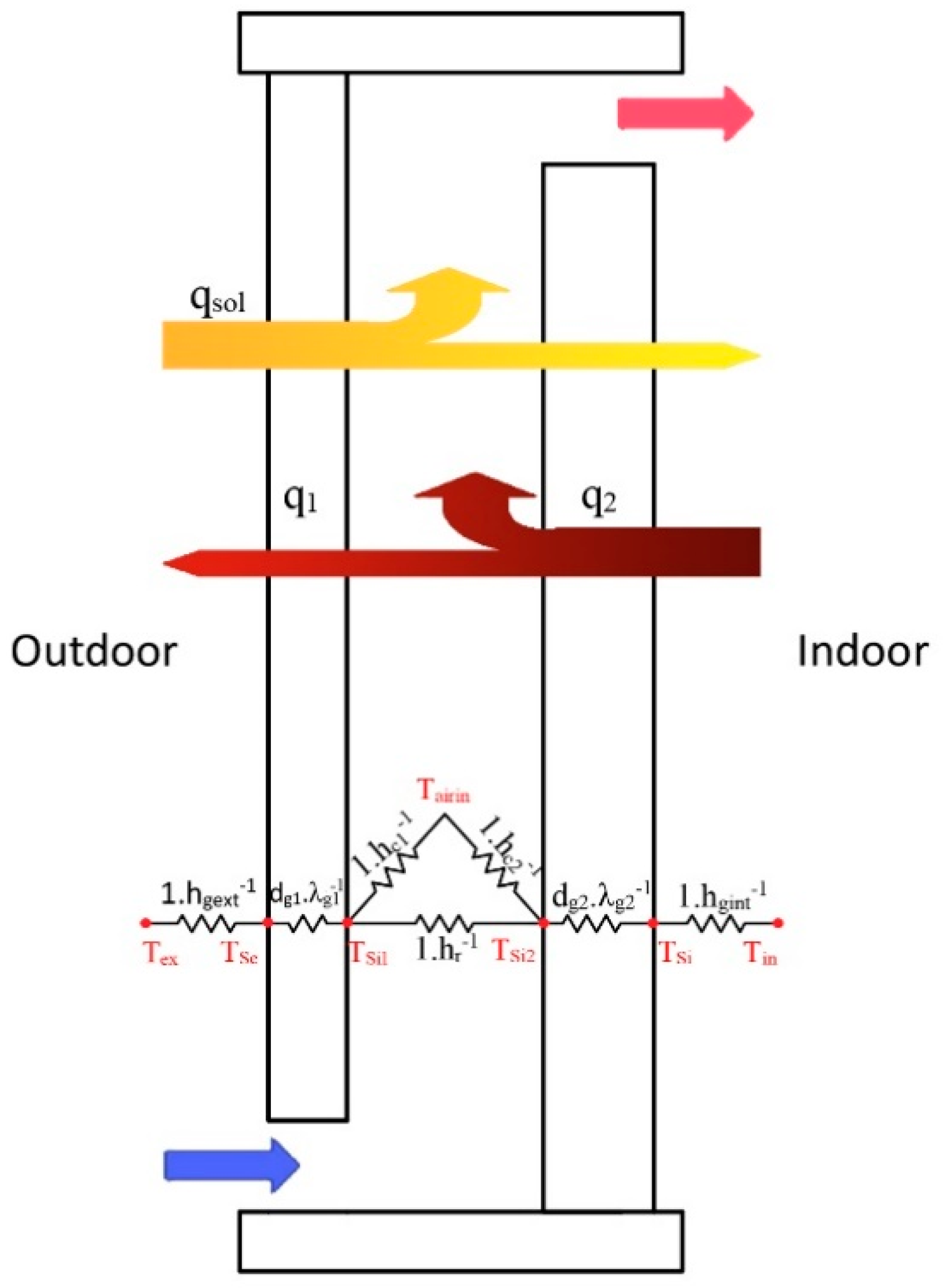

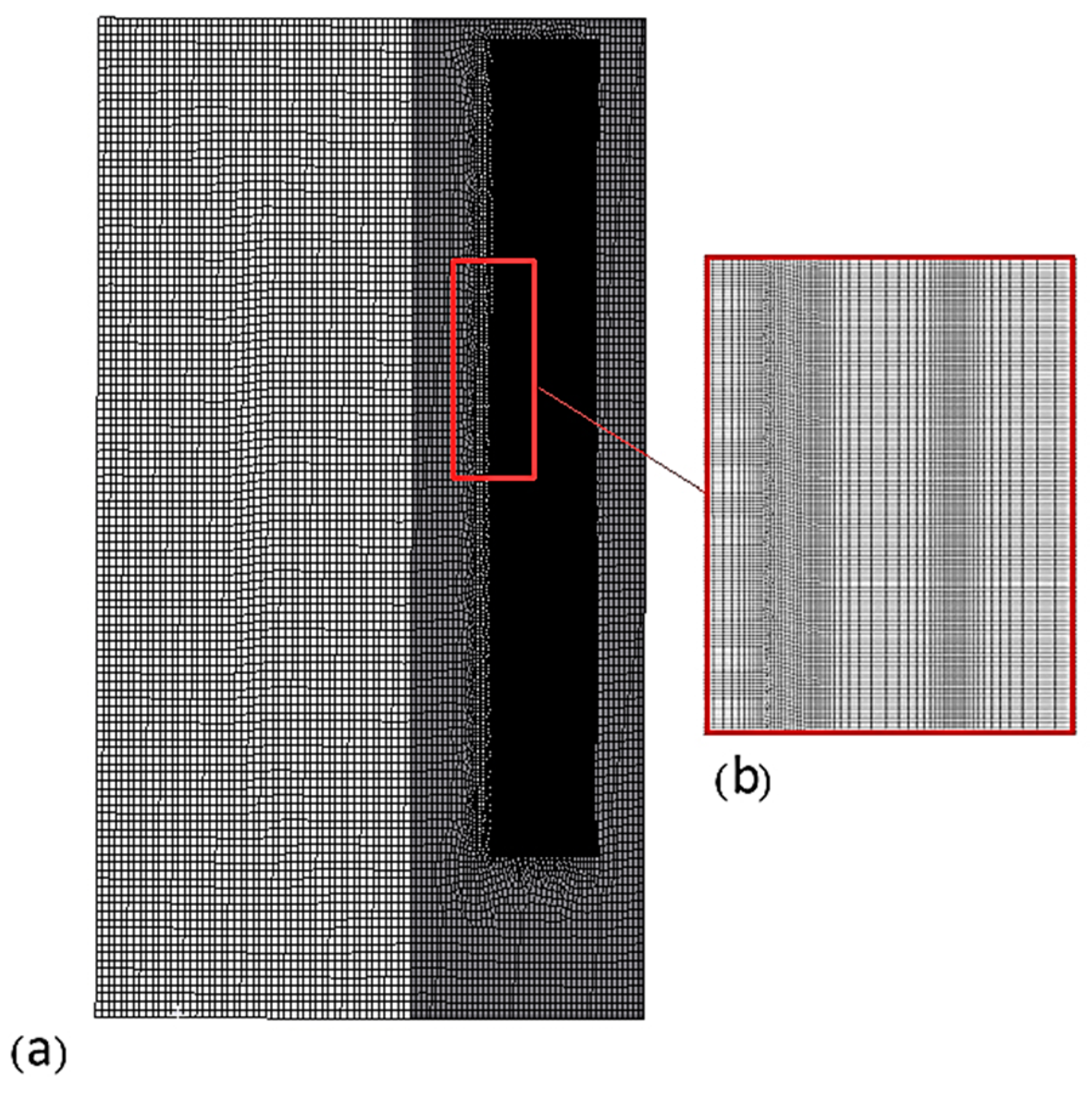
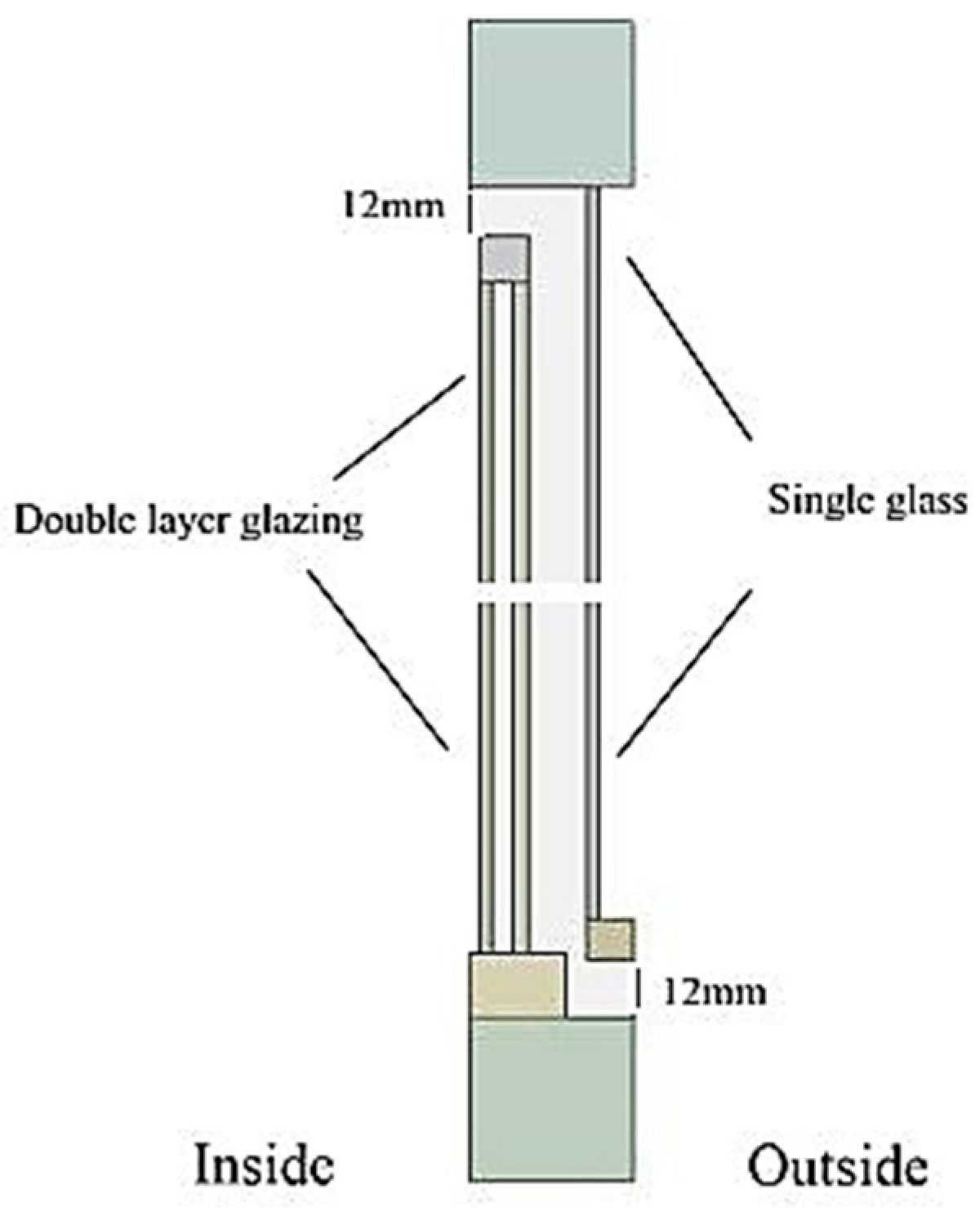
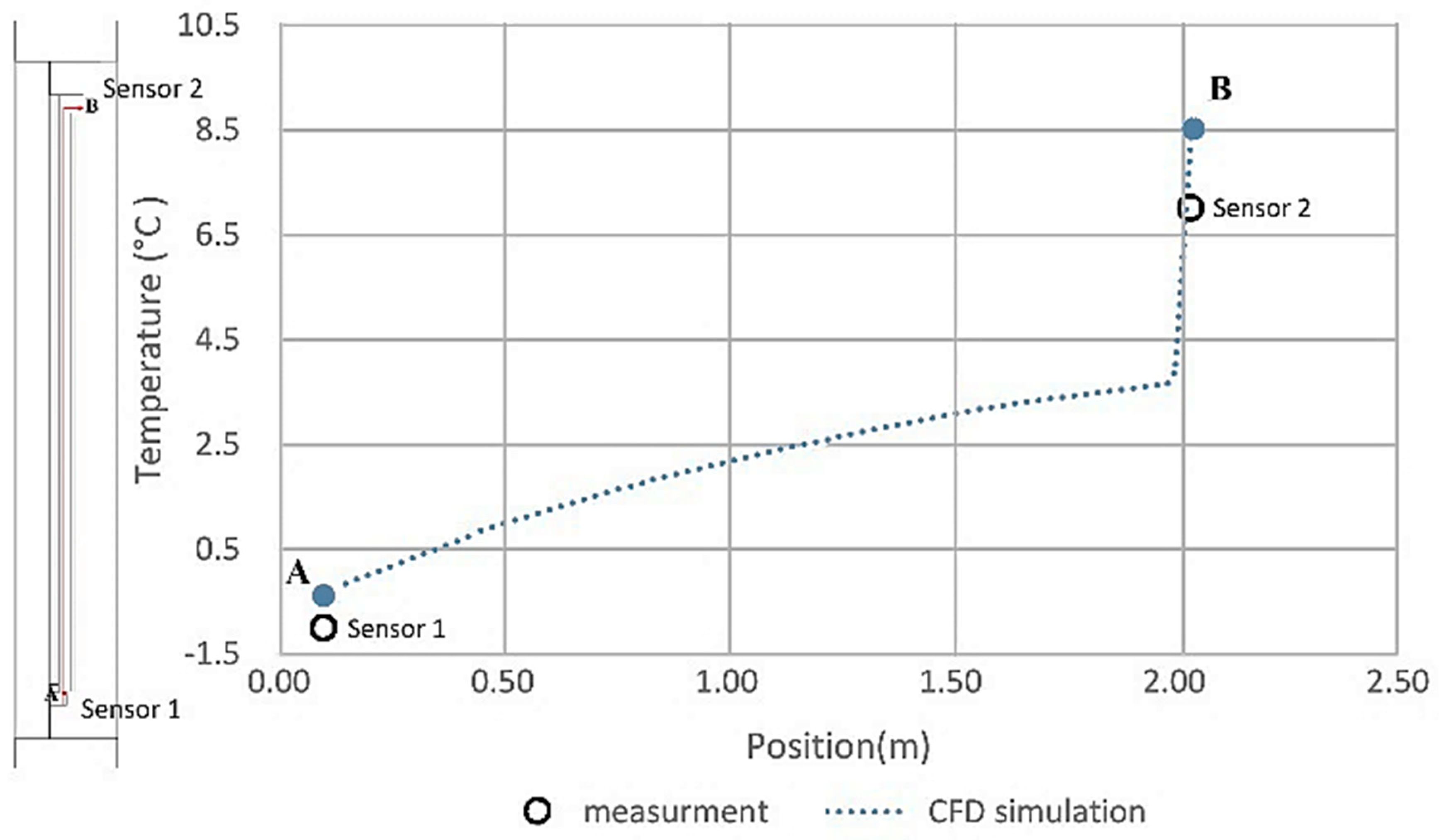

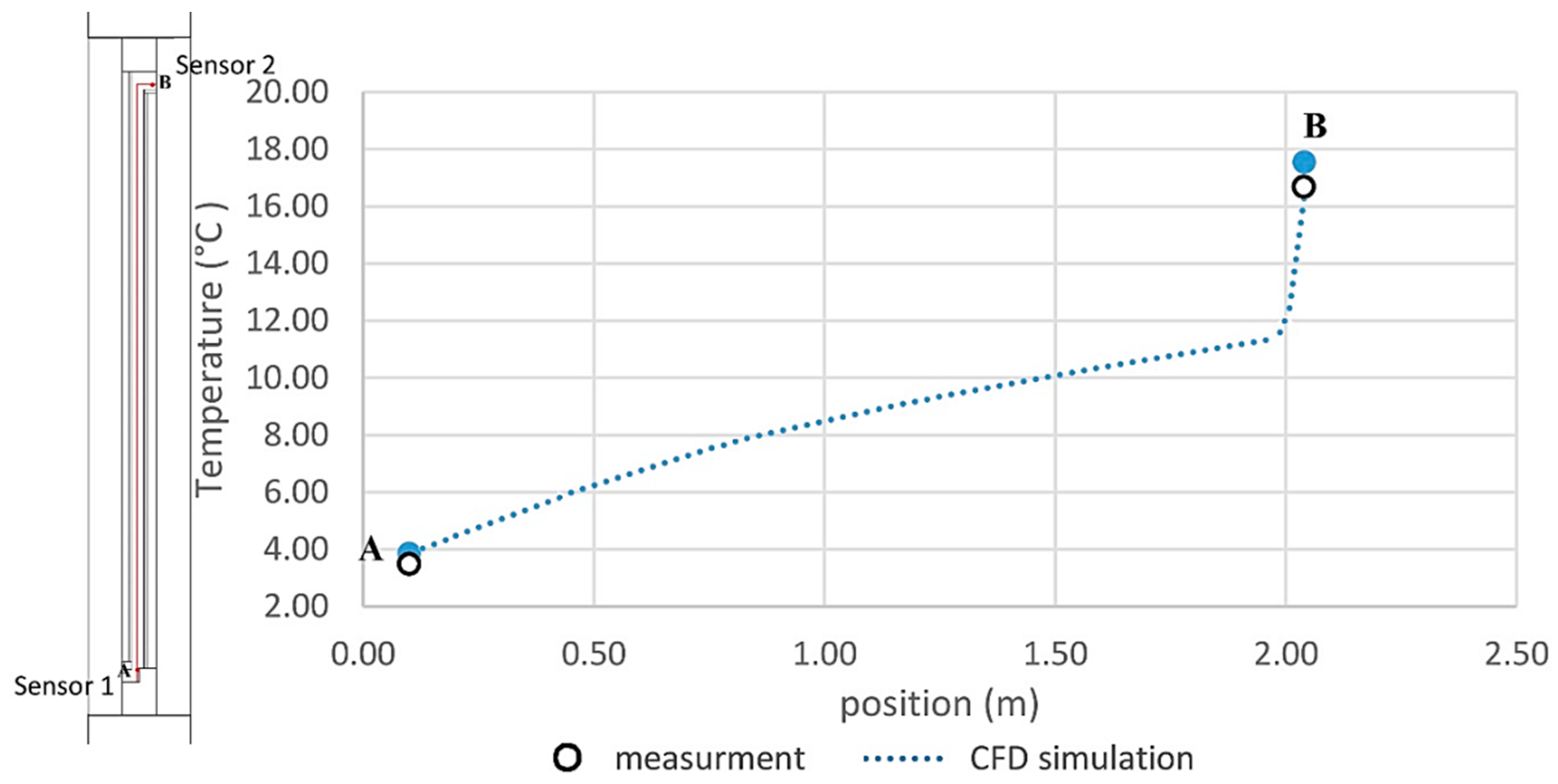
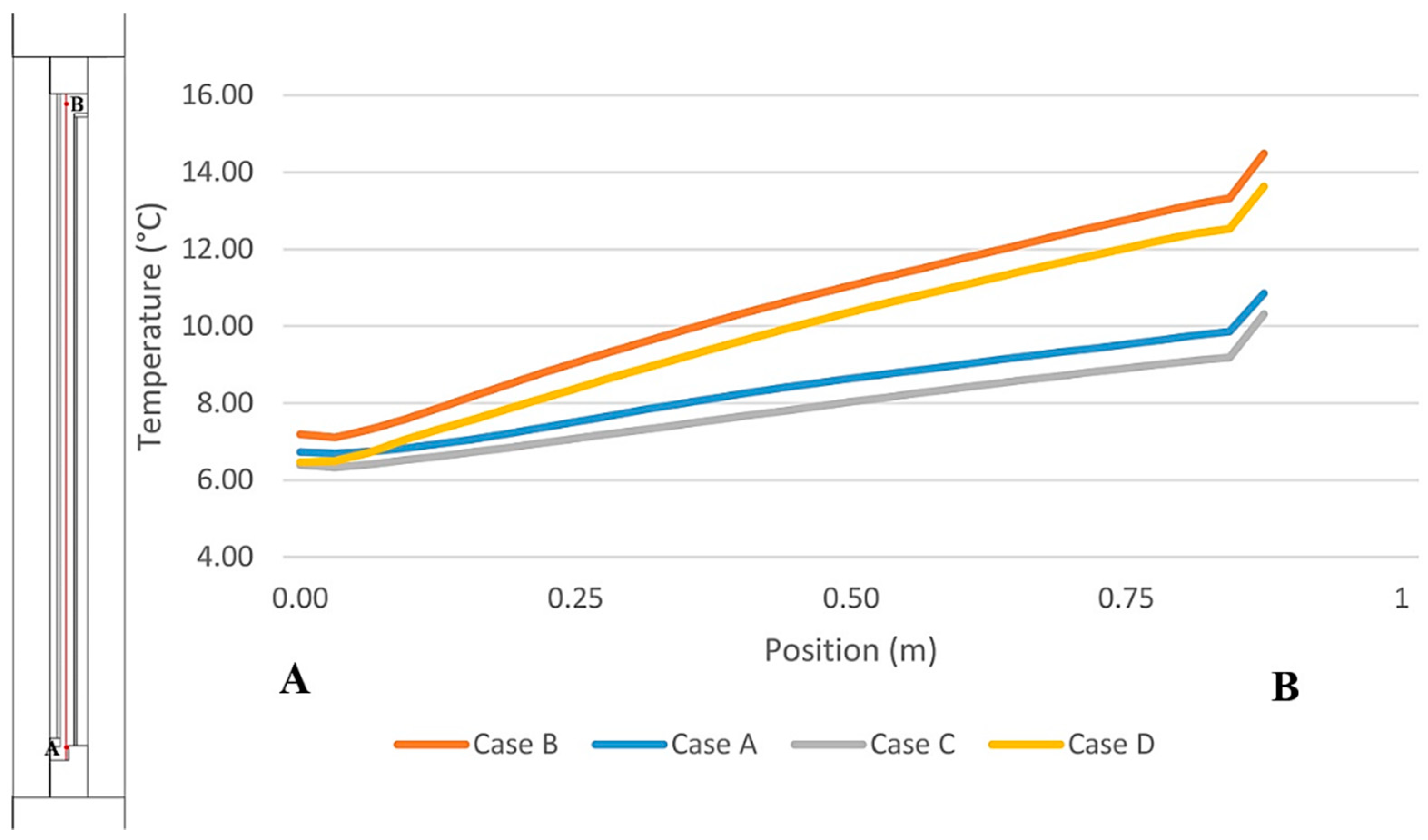

| Ref. | Window Type | Dimension/Coupling/Steady or Transient | Main Objective of the Study | Turbulence and Radiation Modeling |
|---|---|---|---|---|
| [12] | SM | 2D/S/DC | Different glass types, configurations, and ventilation were considered to evaluate the thermal performance of the window in summertime. | K-ε/NS |
| [28] | OAC | 2D/T/DC | The impact of the glazing layer order also ventilation properties on the total solar energy transmittance plus the thermal performance of double façades were evaluated. | Standard K-ε/HS |
| [44] | IM | 3D/S/DC | The heat transfer rate from a window surface was evaluated for different aluminum blade angles for both summer and winter conditions. | K-ε/NS |
| [21] | DSF (OAC) | 3D/S/DC | The impact of blind position, angle, and air outlet position on the airflow development of the window was numerically analyzed. | K-ε realizable/NS |
| [8] | SM, EM | 3D/S/DC | A new method was suggested to apply both in CFD and radiation calculations to determine airflow, and heat transfer within the window. | K-ε RNG/S2S |
| [34] | SM | 3D/S/C | Building energy simulation, moreover integrated CFD was applied to assess the double-skin façade energy performance. | K-ε RANS/NS |
| [27] | DSF (OAC) | 2D/S/DC | A numerical method was employed to evaluate the thermal behavior of the ventilated faced with different angles of the venetian blind. | K-ω model MC model |
| [15] | OAC | 2D/T/DC | The main goal of the study was to investigate the influence of solar radiation on the airflow behavior as well as temperature distribution on a glass façade including external louvers. | K-ε RANS/DO |
| [35] | DSF (SM) | 3D/S/DC | A simple analytical technique was introduced to the contribution of solar radiation in the DSF’s energy balance. | K-ε RANS/HS |
| [31] | OAC | 2D/S/C | To numerically evaluate the buoyancy force and address the high computational cost, the porous model was suggested, and the accuracy of the model was investigated. | Standard K-ε/HS |
| [45] | IAC | 2D/S/DC | Overall forced convective heat transfer within an airflow window was estimated. | K-ε RNG/NS |
| [46] | EM | 3D/T/C | Different building envelopes and building orientations and their effect on DSF thermal performance were examined numerically. | K-ε RNG/DO |
| [14] | SM | 3D/S/DC | The thermal behavior of the supply air window was compared for the natural and forced flow cases. | SST K-ω, DO |
| [47] | EM, OAC | 2D/S/DC | The total heat gain decrease provided by ventilated glazing units was examined to insulated units under summer conditions. A different operating design, as well as optimum cavity space, were investigated. | laminar flow/S2S |
| [1] | SM | 2D/S/DC | CFD simulation was applied to recalculate windows simulation parameters and apply them in a simplified building simulation model. | Laminar, radiative temperature |
| [48] | DSF (OAC) | 3D/T/DC | The impact of various constructions, optical, and operation parameters of a DSF in terms of energy savings was estimated in terms of decreasing the solar load entering the building. | RNG K-ε, P1 radiation model |
| [49] | OAC | 2D/T/O | The CFD and BS models were combined to obtain a realistic picture of the DSF thermal performance. | SST K-ω RANS/NS |
| [50] | DSF (OAC) | 2D/T/DC | The heat transfer of a combined double-skin façade plus phase change material (PCM) blind was evaluated. | K-ε RNG/DO |
| [9] | SM, EM, OAC, IAC | 2D/S/DC | The effect of different glazing, opening, and airflow size on the thermal performance of the airflow window was investigated for both summer and winter time. | Standard K-ε/NS |
| [51] | IM | 2D/S/DC | CFD + ray-tracing method was applied to both standard and complex fenestration systems with integrated blinds, and the results were compared with the ISO 15,099 standard. | K-ε RNG/S2S |
| [52] | OAC, IM | 3D/S/C | The cavity air temperatures plus solar heat gain coefficients (SHGC) were analyzed to the closed and open conditions of the window’s external opening. | Realizable K-ε RANS/S2S |
| [53] | DSF (OAC) | 3D/T/DC | The airflow and heat convection within the cavity was investigated and the results compared with the measurement outcomes. | K-ε model, NS |
| [54] | DSF (OAC) | 3D/S/DC | To analyze the ability of two simulation applications, the thermal performance of DSF was evaluated with Energy Plus and Open FOAM CFD. The results compared with experimental outcomes. | StandardK-ε/NS |
| [55] | OAC | 3D/S/C | The main purpose was to evaluate the influence of colored or low-emissivity glass as an outer pane to improve cooling performance. | K-ε RNG/S2S |
| [56] | ODGU | 2D/S/DC | The numerical analysis on two configurations of ODGU indicated application of (clear glass + air + clear glass) can be the most energy-efficient option for the hot climate. | Laminar, RIM |
| Grid Size of the Cavity (mm) | Mean Temperature °C | Mean Velocity (m·s−1) |
|---|---|---|
| 4 × 4 | 8.718 | 0.315 |
| 3 × 3 | 8.723 | 0.312 |
| 2 × 2 | 8.728 | 0.303 |
| Material | Single Glazing (6 mm) | Low-Emissivity Double-Glazing (4 + 12 + 4 mm) |
|---|---|---|
| Transmittance | 0.752 | 0.305 |
| Reflectance | 0.143 | 0.402 |
| Absorbance | 0.105 | 0.250 |
| Emissivity | 0.84 | 0.148 |
| Thermal conductivity | 1 | 0.043 |
| Variable | Value | Unit |
|---|---|---|
| Irradiance | 180 | W⋅m−2 |
| Wind speed | 3.5 | m·s−1 |
| Outdoor temperature | 3 | °C |
| Cavity Height | Supply Temperature °C | Heat Flux W⋅m−2 | Effectiveness (η-value) | · (L·s−1) | Mean Cavity Temperature °C | Aspect Ratio |
|---|---|---|---|---|---|---|
| 1 m | 16.66 | 1.25 | 0.8 | 2.11 | 8.70 | 20 |
| 2 m | 17.48 | 1.29 | 0.85 | 2.03 | 9.01 | 40 |
| Cavity Depth | Supply Temperature °C | Het flux (W·m−2) | Effectiveness (η-Value) | · (L·s−1) | Mean Cavity Temperature | Aspect Ratio |
|---|---|---|---|---|---|---|
| 25 mm | 16.85 | 0.85 | 0.81 | 2.10 | 8.9 | 40 |
| 50 mm | 16.66 | 1.25 | 0.8 | 2.11 | 8.70 | 20 |
| Case | Width of the Supply Air Opening | Position of the Double-Layered Element |
|---|---|---|
| A | 12 | Inside |
| B | 12 | Outside |
| C | 24 | Inside |
| D | 24 | Outside |
| Cavity Depth | Supply Temperature °C | Effectiveness (η-Value) | · (L·s−1) | Mean Cavity Temperature |
|---|---|---|---|---|
| A | 16.66 | 0.8 | 2.11 | 8.70 |
| B | 17.86 | 0.87 | 2.23 | 10.95 |
| C | 16.26 | 0.78 | 2.10 | 8.63 |
| D | 17.23 | 0.83 | 2.20 | 10.90 |
| Simulated Scenarios | Minimum Surface Temperature | fRsi |
|---|---|---|
| Case A | 8.70 | 0.76 |
| Case B | 10.97 | 0.88 |
| Case C | 8.69 | 0.70 |
| Case D | 10.90 | 0.82 |
Publisher’s Note: MDPI stays neutral with regard to jurisdictional claims in published maps and institutional affiliations. |
© 2021 by the authors. Licensee MDPI, Basel, Switzerland. This article is an open access article distributed under the terms and conditions of the Creative Commons Attribution (CC BY) license (https://creativecommons.org/licenses/by/4.0/).
Share and Cite
Najaf Khosravi, S.; Mahdavi, A. A CFD-Based Parametric Thermal Performance Analysis of Supply Air Ventilated Windows. Energies 2021, 14, 2420. https://doi.org/10.3390/en14092420
Najaf Khosravi S, Mahdavi A. A CFD-Based Parametric Thermal Performance Analysis of Supply Air Ventilated Windows. Energies. 2021; 14(9):2420. https://doi.org/10.3390/en14092420
Chicago/Turabian StyleNajaf Khosravi, Shiva, and Ardeshir Mahdavi. 2021. "A CFD-Based Parametric Thermal Performance Analysis of Supply Air Ventilated Windows" Energies 14, no. 9: 2420. https://doi.org/10.3390/en14092420






